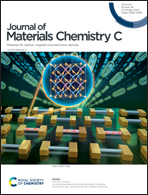Doping engineering of the flexible polyaniline electrochromic material through H2SO4–HClO4 multiple acids for the radiation regulation in snow environment†
Abstract
Flexible polyaniline films doped by H2SO4–HClO4 multiple acids were synthesized, and for the first time, their electrochromic mechanism was studied via optical characterizations from the aspects of polarons and roughness. The electrochromic device based on the doped polyaniline films as the active material exhibits Δε of 0.47 in 8–14 μm and reflectivity higher than 80% in 250–400 nm, which can be integrated with the white snow environment in the UV-vis-infrared spectroscopy due to the sunlight scatter from the abundant micropores. In addition, the device exhibits a superior fast electrochromic behavior and stability of more than 200 cycles without compromising its performance. More importantly, the finite-element method and experimental results demonstrate that the device can achieve thermal management upon flat and twisted configuration. The flexible device shows promise for a broad range of potential applications in optical and thermal regulation systems.



 Please wait while we load your content...
Please wait while we load your content...